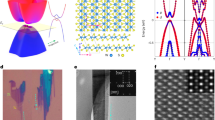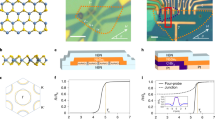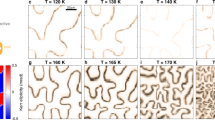Abstract
Time reversal and spatial inversion are two key symmetries for conventional Bardeen–Cooper–Schrieffer (BCS) superconductivity1. Breaking inversion symmetry can lead to mixed-parity Cooper pairing and unconventional superconducting properties1,2,3,4,5. Two-dimensional (2D) NbSe2 has emerged as a new non-centrosymmetric superconductor with the unique out-of-plane or Ising spin–orbit coupling (SOC)6,7,8,9. Here we report the observation of an unusual continuous paramagnetic-limited superconductor–normal metal transition in 2D NbSe2. Using tunelling spectroscopy under high in-plane magnetic fields, we observe a continuous closing of the superconducting gap at the upper critical field at low temperatures, in stark contrast to the abrupt first-order transition observed in BCS thin-film superconductors10,11,12. The paramagnetic-limited continuous transition arises from a large spin susceptibility of the superconducting phase due to the Ising SOC. The result is further supported by self-consistent mean-field calculations based on the ab initio band structure of 2D NbSe2. Our findings establish 2D NbSe2 as a promising platform to explore novel spin-dependent superconducting phenomena and device concepts1, such as equal-spin Andreev reflection13 and topological superconductivity14,15,16.
This is a preview of subscription content, access via your institution
Access options
Access Nature and 54 other Nature Portfolio journals
Get Nature+, our best-value online-access subscription
$29.99 / 30 days
cancel any time
Subscribe to this journal
Receive 12 print issues and online access
$259.00 per year
only $21.58 per issue
Buy this article
- Purchase on Springer Link
- Instant access to full article PDF
Prices may be subject to local taxes which are calculated during checkout



Similar content being viewed by others
References
Bauer, E. & Sigrist, M. Non-centrosymmetric Superconductors: Introduction and Overview (Springer, Berlin, Heidelberg, 2012).
Bauer, E. et al. Heavy fermion superconductivity and magnetic order in noncentrosymmetric CePt3Si. Phys. Rev. Lett. 92, 027003 (2004).
Yogi, M. et al. Evidence for novel pairing state in noncentrosymmetric superconductor CePt3Si: 29Si-NMR knight shift study. J. Phys. Soc. Jpn. 75, 013709 (2006).
Yip, S. Noncentrosymmetric superconductors. Annu. Rev. Condens. Matter Phys. 5, 15–33 (2014).
Smidman, M., Salamon, M. B., Yuan, H. Q. & Agterberg, D. F. Superconductivity and spin–orbit coupling in non-centrosymmetric materials: a review. Rep. Progress. Phys. 80, 036501 (2017).
Cao, Y. et al. Quality heterostructures from two-dimensional crystals unstable in air by their assembly in inert atmosphere. Nano Lett. 15, 4914–4921 (2015).
Tsen, A. W. et al. Nature of the quantum metal in a two-dimensional crystalline superconductor. Nat. Phys. 12, 208–212 (2016).
Ugeda, M. M. et al. Characterization of collective ground states in single-layer NbSe2. Nat. Phys. 12, 92–97 (2016).
Xi, X. et al. Ising pairing in superconducting NbSe2 atomic layers. Nat. Phys. 12, 139–143 (2016).
Meservey, R. & Tedrow, P. M. Spin-polarized electron-tunneling. Phys. Rep. 238, 173–243 (1994).
Meservey, R., Tedrow, P. M. & Bruno, R. C. Tunneling measurements on spin-paired superconductors with spin–orbit scattering. Phys. Rev. B 11, 4224–4235 (1975).
Adams, P. W., Herron, P. & Meletis, E. I. First-order spin-paramagnetic transition and tricritical point in ultrathin Be films. Phys. Rev. B 58, R2952–R2955 (1998).
Zhou, B. T., Yuan, N. F., Jiang, H.-L. & Law, K. T. Ising superconductivity and Majorana fermions in transition-metal dichalcogenides. Phys. Rev. B 93, 180501 (2016).
Yuan, N. F., Mak, K. F. & Law, K. T. Possible topological superconducting phases of MoS2. Phys. Rev. Lett. 113, 097001 (2014).
He, W.-Y. et al. Magnetic field driven nodal topological superconductivity in monolayer transition metal dichalcogenides. Preprint at https://arxiv.org/abs/1604.02867 (2016).
Hsu, Y.-T., Vaezi, A., Fischer, M. H. & Kim, E.-A. Topological superconductivity in monolayer transition metal dichalcogenides. Nat. Commun. 8, 14985 (2017).
Tinkham, M. Introduction to Superconductivity (McGraw-Hill, New York, NY, 2004).
Liu, C. X. Unconventional superconductivity in bilayer transition metal dichalcogenides. Phys. Rev. Lett. 118, 087001 (2017).
Frigeri, P. A., Agterberg, D. F. & Sigrist, M. Spin susceptibility in superconductors without inversion symmetry. New J. Phys. 6, 115 (2004).
Gor’kov, L. P. & Rashba, E. I. Superconducting 2D system with lifted spin degeneracy: mixed singlet–triplet state. Phys. Rev. Lett. 87, 037004 (2001).
Yip, S. K. Two-dimensional superconductivity with strong spin–orbit interaction. Phys. Rev. B 65, 144508 (2002).
Wakatsuki, R. & Law, K.T. Proximity effect and Ising superconductivity in superconductor/transition metal dichalcogenide heterostructures. Preprint at https://arxiv.org/abs/1604.04898 (2016).
Lu, J. M. et al. Evidence for two-dimensional Ising superconductivity in gated MoS2. Science 350, 1353 (2015).
Saito, Y. et al. Superconductivity protected by spin–valley locking in ion-gated MoS2. Nat. Phys. 12, 144–149 (2015).
Nam, H. et al. Ultrathin two-dimensional superconductivity with strong spin–orbit coupling. Proc. Natl Acad. Sci. USA 113, 10513–10517 (2016).
Xi, X. et al. Strongly enhanced charge–density–wave order in monolayer NbSe2. Nat. Nanotec. 10, 765–769 (2015).
Daghero, D. & Gonnelli, R. S. Probing multiband superconductivity by point-contact spectroscopy. Supercond. Sci. Technol. 23, 043001 (2010).
Webb, G. W., Marsiglio, F. & Hirsch, J. E. Superconductivity in the elements, alloys and simple compounds. Phys. C 514, 17–27 (2015).
Bianchi, A. et al. First-order superconducting phase transition in CeCoIn5. Phys. Rev. Lett. 89, 137002 (2002).
Radovan, H. A. et al. Magnetic enhancement of superconductivity from electron spin domains. Nature 425, 51–55 (2003).
Lortz, R. et al. Calorimetric evidence for a Fulde–Ferrell–Larkin–Ovchinnikov superconducting state in the layered organic superconductor κ-(BEDT-TTF)2Cu(NCS)2. Phys. Rev. Lett. 99, 187002 (2007).
Zocco, D. A., Grube, K., Eilers, F., Wolf, T. & von Löhneysen, H. Pauli-limited multiband superconductivity in KFe2As2. Phys. Rev. Lett. 111, 057007 (2013).
Kiss, T. et al. Charge-order-maximized momentum-dependent superconductivity. Nat. Phys. 3, 720–725 (2007).
Acknowledgements
This research was supported by the ARO Award W911NF-17-1-0605 for the sample and device fabrication and the US Department of Energy, Office of Basic Energy Sciences contract no. DESC0013883 for the tunelling spectroscopy measurements. A portion of this work was performed at the NHMFL, which is supported by National Science Foundation (NSF) Cooperative Agreement no. DMR-1644779 and the State of Florida. The work in Hong Kong was supported by the Croucher Foundation, the Dr. Tai-chin Lo Foundation and the Hong Kong Research Grants Council through HKUST3/CRF/13 G, C6026-16W and 16324216. The work in Lausanne was supported by the Swiss National Science Foundation. We also acknowledge support from the NSF under Award nos DMR-1645901 (E.S.), DMR-1420451 (K.K.) and DMR-1410407 (Z.W.) and a David and Lucille Packard Fellowship and a Sloan Fellowship (K.F.M.).
Author information
Authors and Affiliations
Contributions
E.S., J.S. and K.F.M. designed the experiments. E.S. fabricated the devices and performed the measurements with the assistance of S.J., Z.W. and K.K., and of J.-H.P. at the NHMFL. X.X. contributed to all aspects of the experiment in its early phase. W.-Y.H. and K.T.L. performed the theoretical work. H.B. and L.F. synthesized the bulk NbSe2 crystals and screened the sample quality. E.S., W.H., K.T.L., J.S. and K.F.M. analysed the data and co-wrote the paper. All the authors discussed the results and commented on the manuscript.
Corresponding authors
Ethics declarations
Competing interests
The authors declare no competing interests.
Additional information
Publisher’s note: Springer Nature remains neutral with regard to jurisdictional claims in published maps and institutional affiliations.
Supplementary information
Supplementary Information
Supplementary Sections 1–6, Supplementary Figures 1–16, Supplementary Table 1, Supplementary References
Rights and permissions
About this article
Cite this article
Sohn, E., Xi, X., He, WY. et al. An unusual continuous paramagnetic-limited superconducting phase transition in 2D NbSe 2 . Nature Mater 17, 504–508 (2018). https://doi.org/10.1038/s41563-018-0061-1
Received:
Accepted:
Published:
Issue Date:
DOI: https://doi.org/10.1038/s41563-018-0061-1
This article is cited by
-
Topotactic fabrication of transition metal dichalcogenide superconducting nanocircuits
Nature Communications (2023)
-
Superconducting dome by tuning through a van Hove singularity in a two-dimensional metal
npj 2D Materials and Applications (2023)
-
Magnetic field orientation dependence of planar tunneling spectroscopy in the superconducting state of NbSe2
Quantum Frontiers (2023)
-
Gate-tunable pairing channels in superconducting non-centrosymmetric oxides nanowires
npj Quantum Materials (2022)
-
Fermi surface chirality induced in a TaSe2 monosheet formed by a Ta/Bi2Se3 interface reaction
Nature Communications (2022)



